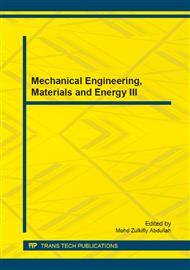[1]
J. Kotowicz and Ł. Bartela, Optimisation of the connection of membrane ccs installation with a supercritical coal-fired power plant, Energy 38(1), p.118–127, (2012).
DOI: 10.1016/j.energy.2011.12.028
Google Scholar
[2]
W. M. Budzianowski, An oxy-fuel mass-recirculating process for H2 production with CO2 capture by autothermal catalytic oxyforming of methane, International Journal of Hydrogen Energy 35(14), p.7454–7469, (2010).
DOI: 10.1016/j.ijhydene.2010.04.178
Google Scholar
[3]
G. Wiciak and J. Kotowicz, Experimental stand for co2 membrane separation, Journal of Power Technologies 91(4), p.171–178, (2011).
Google Scholar
[4]
M. Kawabata, O. Kurata, N. Iki, C. Fushimi, and A. Tsutsumi, Analysis of igfc with exergy recuperation and carbon dioxide separation unit, Proceedings of the ASME Turbo Expo 3, p.441–448, (2012).
DOI: 10.1115/gt2012-69999
Google Scholar
[5]
K. Janusz-Szymańska, Economic efficiency of an igcc system integreted with ccs installation [efektywność ekonomiczna układu gazowo-parowego zintegrowanego ze zgazowaniem węgla oraz z instalacjaą CCS], Rynek Energii 102(5), p.24–30, (2012).
Google Scholar
[6]
L. Bartela, A. Skorek-Osikowska, and J. Kotowicz, Integration of a supercritical coal-fired heat and power plant with carbon capture installation and gas turbine [integracja bloku elektrociepłowni weglowej na parametry nadkrytyczne z instalacja wychwytu dwutlenku wegla oraz turbina gazowa], Rynek Energii 100(3), p.56–62, (2012).
DOI: 10.1016/j.energy.2013.11.048
Google Scholar
[7]
G. Discepoli, G. Cinti, U. Desideri, D. Penchini, and S. Proietti, Carbon capture with molten carbonate fuel cells: Experimental tests and fuel cell performance assessment, International Journal of Greenhouse Gas Control 9, p.372–384, (2012).
DOI: 10.1016/j.ijggc.2012.05.002
Google Scholar
[8]
G. De Lorenzo and P. Fragiacomo, Electrical and electrical-thermal power plants with molten carbonate fuel cell/gas turbine-integrated systems, International Journal of Energy Research 36(2), p.153–165, (2012).
DOI: 10.1002/er.1788
Google Scholar
[9]
G. De Lorenzo and P. Fragiacomo, A methodology for improving the performance of molten carbonate fuel cell/gas turbine hybrid systems, International Journal of Energy Research 36(1), p.96–110, (2012).
DOI: 10.1002/er.1789
Google Scholar
[10]
H. Jeong, S. Cho, D. Kim, H. Pyun, D. Ha, C. Han, M. Kang, M. Jeong, and S. Lee, A heuristic method of variable selection based on principal component analysis and factor analysis for monitoring in a 300 kw mcfc power plant, International Journal of Hydrogen Energy 37(15), p.11394–11400, (2012).
DOI: 10.1016/j.ijhydene.2012.04.135
Google Scholar
[11]
J. Milewski, J. Lewandowski, and A. Miller, Reducing CO2 emissions from a coal fired power plant by using a molten carbonate fuel cell, in ASME Turbo EXPO, Proceedings of the ASME Turbo Expo 2, p.389–395, (2008).
DOI: 10.1115/gt2008-50100
Google Scholar
[12]
A. Sobolewski, . Bartela, A. Skorek-Osikowska, and T. Iluk, Comparison of the economic efficiency of chp plants integrated with gazela generator [porównanie efektywności ekonomicznej układów kogeneracyjnych z generatorem gazu procesowego gazela], Rynek Energii 102(5), p.31–37, (2012).
Google Scholar
[13]
J. Milewski and J. Lewandowski, Solid oxide fuel cell fuelled by biogases, Archives of Thermodynamics 30(4), p.3–12, (2009).
Google Scholar
[14]
J. Chawla, Waste heat recovery from flue gases with substantial dust load, Chemical Engineering and Processing 38, p.365–371, (1999).
DOI: 10.1016/s0255-2701(99)00027-6
Google Scholar
[15]
J. Kotowicz and Ł. Bartela, The influence of economic parameters on the optimal values of the design variables of a combined cycle plant, Energy 35(2), p.911–919, (2010).
DOI: 10.1016/j.energy.2009.07.014
Google Scholar
[16]
C. Butcher and B. Reddy, Second law analysis of a waste heat recovery based power generation system, International Journal of Heat and Mass Transfer 50(11), p.2355–2363, (2007).
DOI: 10.1016/j.ijheatmasstransfer.2006.10.047
Google Scholar
[17]
J. -Y. San, Second-law performance of heat exchangers for waste heat recovery, Energy 35(5), p.1936–1945, (2010).
DOI: 10.1016/j.energy.2010.01.007
Google Scholar
[18]
G. Descombes and S. Boudigues, Modelling of waste heat recovery for combined heat and power applications, Applied Thermal Engineering 29(13), p.2610–2616, (2009).
DOI: 10.1016/j.applthermaleng.2008.09.019
Google Scholar
[19]
S. M. Lai, H. Wu, C. W. Hui, B. Hua, and G. Zhang, Flexible heat exchanger network design for low-temperature heat utilization in oil refinery, Asia-Pacific Journal of Chemical Engineering 6(5), p.713–733, (2011).
DOI: 10.1002/apj.511
Google Scholar
[20]
S. Wu, X. Yuan, Y. Li, and L. Peng, Exergy transfer characteristics on low temperature heat exchangers, International Journal of Modern Physics B 21(18n19), p.3503–3505, (2007).
DOI: 10.1142/s0217979207044846
Google Scholar
[21]
L. Peng, Y. -R. Li, S. -Y. Wu, and B. Lan, The analysis of exergy efficiency in the low temperature heat exchanger, International Journal of Modern Physics B 21(18n19), p.3497–3499, (2007).
DOI: 10.1142/s0217979207044822
Google Scholar
[22]
S. Wu, Y. Li, and D. Zeng, Exergo-economic performance evaluation on low temperature heat exchanger, International Journal of Modern Physics B 19(01n03), p.517–519, (2005).
DOI: 10.1142/s0217979205028943
Google Scholar
[23]
F. Starfelt, E. Thorin, E. Dotzauer, and J. Yan, Performance evaluation of adding ethanol production into an existing combined heat and power plant, Bioresource technology 101(2), p.613–618, (2010).
DOI: 10.1016/j.biortech.2009.07.087
Google Scholar
[24]
K. Badyda, J. Milewski, and M. Wołowicz, Model of 800 MW condensation power plant unit using GateCycletm aplication, in 50 Sympozjon Modelowanie w Mechanice, (2011).
Google Scholar


